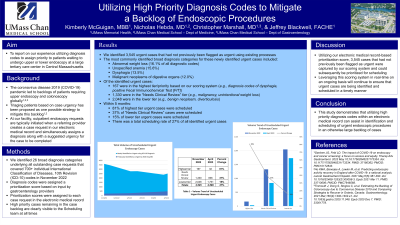Tuesday Poster Session
Category: Practice Management
P4044 - Utilizing High Priority Diagnosis Codes to Mitigate a Backlog of Endoscopic Procedures
Tuesday, October 24, 2023
10:30 AM - 4:00 PM PT
Location: Exhibit Hall

Has Audio
- NH
Nicholas Hebda, MD
UMass Chan Medical School
Worcester, MA
Presenting Author(s)
Nicholas Hebda, MD1, Kimberly McGuigan, BS2, Christopher Marshall, MD1
1UMass Chan Medical School, Worcester, MA; 2UMass Memorial Medical Center, Worcester, MA
Introduction: Endoscopic gastrointestinal procedures were among various medical interventions curtailed by the coronavirus disease 2019 (COVID-19) pandemic, leading to backlogs of patients requiring upper endoscopy and colonoscopy globally. Among several strategies that have been proposed to mitigate this backlog is that of triaging patients based on case urgency. Here, we report on our experience utilizing diagnosis codes to assign priority to patients waiting to undergo upper or lower endoscopy at a large tertiary care center in Central Massachusetts.
Methods: At our facility, outpatient endoscopy requests (screening, surveillance, or diagnostic) are typically initiated when a referring provider creates a case request in our electronic medical record and provides a suggested urgency for the case to be scheduled. Out of concern that additional urgent cases were possibly not being captured as our case backlog grew, we identified 26 broad diagnosis categories underlying these case requests that covered 700+ individual International Classification of Diseases, 10th Revision (ICD-10) codes. Diagnosis codes were assigned a prioritization score based on input by gastroenterology providers. Prioritization scores were assigned to each case request in the electronic medical record and the high priority cases remaining in the case backlog were clearly visible to the Scheduling team at all times.
Results: Utilizing our new prioritization scores, we identified 3,545 urgent cases in November 2022 that had not previously been captured by our existing protocol. The most commonly identified broad diagnosis categories for these cases included abnormal weight loss (16.1% of all diagnostic codes), unspecified anemia (15.6%), dysphagia (13.5%), and malignant neoplasms of digestive organs (12.0%). Of the identified urgent cases, 167 were in the highest tier/priority based on our scoring system (e.g., diagnosis code of positive Fecal Immunochemical Test [FIT]), 1,330 were in the middle tier (e.g., malignancy), and 2,048 were in the lower tier (e.g., benign neoplasm). Within 5 months, 81% of highest tier urgent cases were completed, 37% of middle tier urgent cases were completed, and 15% of lower tier urgent cases were completed, with a total completion of 27% of all identified urgent cases.
Discussion: This study demonstrates that utilizing high priority diagnosis codes within an electronic medical record can assist in identification and completion of urgent endoscopic procedures in an otherwise large backlog of cases.
Disclosures:
Nicholas Hebda, MD1, Kimberly McGuigan, BS2, Christopher Marshall, MD1. P4044 - Utilizing High Priority Diagnosis Codes to Mitigate a Backlog of Endoscopic Procedures, ACG 2023 Annual Scientific Meeting Abstracts. Vancouver, BC, Canada: American College of Gastroenterology.
1UMass Chan Medical School, Worcester, MA; 2UMass Memorial Medical Center, Worcester, MA
Introduction: Endoscopic gastrointestinal procedures were among various medical interventions curtailed by the coronavirus disease 2019 (COVID-19) pandemic, leading to backlogs of patients requiring upper endoscopy and colonoscopy globally. Among several strategies that have been proposed to mitigate this backlog is that of triaging patients based on case urgency. Here, we report on our experience utilizing diagnosis codes to assign priority to patients waiting to undergo upper or lower endoscopy at a large tertiary care center in Central Massachusetts.
Methods: At our facility, outpatient endoscopy requests (screening, surveillance, or diagnostic) are typically initiated when a referring provider creates a case request in our electronic medical record and provides a suggested urgency for the case to be scheduled. Out of concern that additional urgent cases were possibly not being captured as our case backlog grew, we identified 26 broad diagnosis categories underlying these case requests that covered 700+ individual International Classification of Diseases, 10th Revision (ICD-10) codes. Diagnosis codes were assigned a prioritization score based on input by gastroenterology providers. Prioritization scores were assigned to each case request in the electronic medical record and the high priority cases remaining in the case backlog were clearly visible to the Scheduling team at all times.
Results: Utilizing our new prioritization scores, we identified 3,545 urgent cases in November 2022 that had not previously been captured by our existing protocol. The most commonly identified broad diagnosis categories for these cases included abnormal weight loss (16.1% of all diagnostic codes), unspecified anemia (15.6%), dysphagia (13.5%), and malignant neoplasms of digestive organs (12.0%). Of the identified urgent cases, 167 were in the highest tier/priority based on our scoring system (e.g., diagnosis code of positive Fecal Immunochemical Test [FIT]), 1,330 were in the middle tier (e.g., malignancy), and 2,048 were in the lower tier (e.g., benign neoplasm). Within 5 months, 81% of highest tier urgent cases were completed, 37% of middle tier urgent cases were completed, and 15% of lower tier urgent cases were completed, with a total completion of 27% of all identified urgent cases.
Discussion: This study demonstrates that utilizing high priority diagnosis codes within an electronic medical record can assist in identification and completion of urgent endoscopic procedures in an otherwise large backlog of cases.
Disclosures:
Nicholas Hebda indicated no relevant financial relationships.
Kimberly McGuigan indicated no relevant financial relationships.
Christopher Marshall indicated no relevant financial relationships.
Nicholas Hebda, MD1, Kimberly McGuigan, BS2, Christopher Marshall, MD1. P4044 - Utilizing High Priority Diagnosis Codes to Mitigate a Backlog of Endoscopic Procedures, ACG 2023 Annual Scientific Meeting Abstracts. Vancouver, BC, Canada: American College of Gastroenterology.
